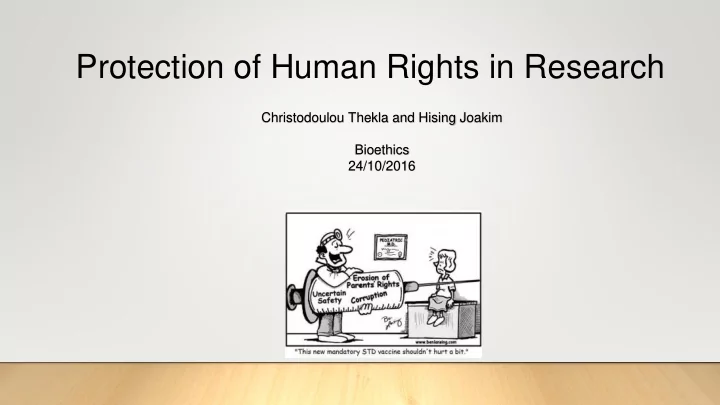

Protection of Human Rights in Research Christodoulou Thekla and Hising Joakim Bioethics 24/10/2016
Overview What do we mean by ”protection” and what do we protect? Historical background Ethical conflicts within known cases Discussion points
Protection?
Protection? • Health • Law • Scientific design • Research • Integrity • Susceptibility
Chart flow for History of events: • Nazi Medical War Crimes: During the Nazi era, experiments were performed on non-consenting subjects. 1939-1945 • Nuremberg Doctors’ Trial: The individuals who conducted Nazi experiments during WWII were tried separately from other war criminals because of their professional status as physicians and the horrendous and unique nature of their crimes. They were found guilty of “crimes against humanity” . 1946 • Nuremberg code: Nazis physicians are tried at Nuremberg, Germany, for research atrocities performed on Prisoners of war. This resulted in the Nuremberg Code, the first internationally recognized code of research ethics, 1947 issued by the Nazi War Crimes Tribunal.
Nazi Medical War Crimes (1939-1945) German physicians adopting a “Euthanasia” program: victims deemed of “unworthy of life” “Medical experiments” performed on thousands of concentration camp prisoners without informant consent Included deadly studies and tortures, e.g. injecting people with gasoline and live viruses, immersing people in ice water, forcing people to ingest poisons As a result, many dead or permanently crippled victims Unethical and gruesome experiments Development and testing of pharmaceuticals for Advance racial and Survival of Axis alliance German military/soldiers ideological beliefs of the military personnel: in the field: Nazi worldview: A victim of a Nazi medical experiment is -high altitude -immunization -serological experiments immersed in icy water at the Dachau experiments experiments -sterilization concentration camp. SS doctor Sigmund -freezing experiments Nazi physician Carl Clauberg (at left), -bone-grafting experiments Rascher oversees the experiment. who performed medical experiments on experiments Germany, 1942. prisoners in Block 10 of the Auschwitz -gas experiments camp. Poland, between 1941 and 1944.
Nuremberg code (1947): First modern ethical code Set of research ethics principles for human experimentation Ethical standard of medical behavior accepted worldwide and established at the Nuremberg trials Consequence of Nazi crimes of violating human rights during World War II Free power of choice and sufficient knowledge of the research Voluntary informed objectives consent Likelihood of some good resulting Scientific Studies Based on prior Animal model experimentation research Avoidance of Unnecessary injury and suffering physical or psychological harm Benefits should Humanitarian importance above anything else outweigh risks Newspaper of The New York Times, October 19, 1945, indicating the beginning of Nuremberg trials Qualified Proper experience of researcher investigators Right to withdraw Freedom of liberty consent Termination of Research must stop if harm is resulting studies
Did things get better after the Nuremberg Trials?
Chart flow for History of events: • Syphilis Study at Tuskegee: Long-term study of the effects of untreated Syphilis. 1932- 1972 • Cold War Human Radiation Experiments, US: More than 400 experiments to determine the effects of exposure to ionizing radiation on human health or to 1944- calibrate instruments designed to detect radiation. 1974 • Fernald state school, Massachusetts: 19 boys who thought they were participating in a science club were fed radioactive milk by researchers who 1946- wanted to learn about the digestive system. 1956 • Jewish Chronic Disease Hospital Study: Studies to develop information about the human immune system’s response to cancer. 1963
Jewish Chronic Disease Hospital study (1963) Studies to develop information on the nature of the human transplant rejection process Involved injection of live cancer cells into patients who were hospitalized with various chronic diseases Researchers stated that consent was given orally, but not documented: - Documentation was not necessary - More dangerous medical procedures are undertaken without the use of consent forms - Would scare the patients unreasonably - Good cause of action True nature of study: Deceiving and unprofessional conduct from the researchers
Chart flow for History of events: • Declaration of Helsinki: The World Medical Association drafted the first international agreement recommending ethical standards 1964 for clinical research.
The Belmont report (1979) Ethical principles and guidelines for the protection of human subjects in research Consequence of previous human subject violations • Practice: (A) Defined boundaries Outcome : Reasonable expectation of success between research and • Research: practice Outcome : Permits a conclusion to be drawn • Respect for Persons: -Having the right to self-govern (autonomy) -Informed consent (B) Consists of 3 basic • Beneficence : principles -Benefits outweigh the risks • Justice : -Equitable selection of participants -Fairness in distributing benefits • Serve to preserve the public trust in research (C) Overall emphasis of • Protection of human exploitation the principles • Special protection for most vulnerable (e.g. children, pregnant women, prisoners)
Puffenberger et al 2004
Puffenberger et al 2004
Cases for discussion A) Case poly-pharmaca: A medical doctor has observed good treatment effect in two different drugs and wants to try giving both drugs simultaneously to a group of his patients. However, there is a problem; the two drugs have never been combined before. Do you think the doctor should be allowed to give the drug combination to his patients? B) Modern case: Berlin patient Timothy Ray Brown, long known only as the "Berlin Patient" had HIV for 12 years before he became the first person in the world to be cured of the infection following a stem cell transplant in 2007.
Recommend
More recommend